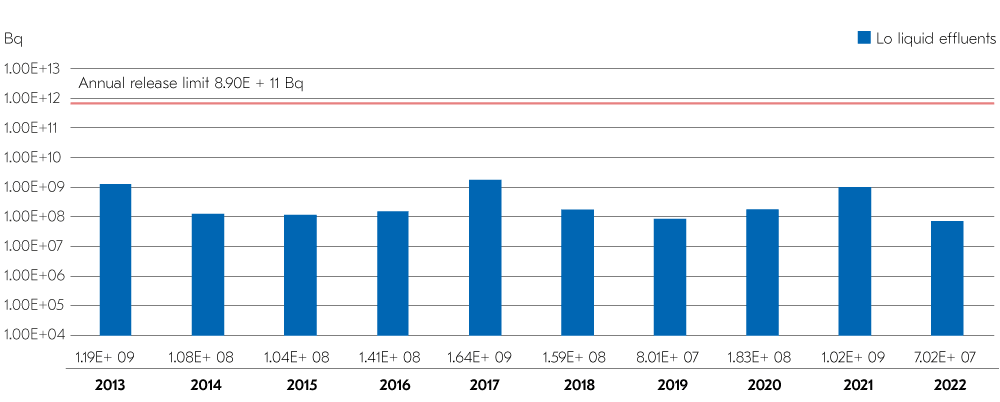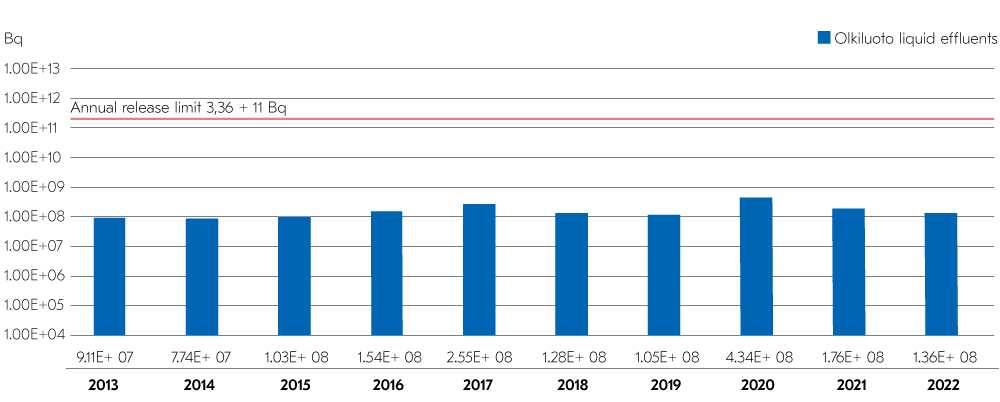Radiation safety of nuclear facilities
Control of radiation safety is a part of the supervision of the operating condition of a nuclear power plant. The objective is to ensure that the total radiation exposure caused by the operation of the nuclear power plant to both workers and residents of the surrounding area is kept as low as practically possible. At the individual level, radiation exposure is kept well below the dose limits.
Radiation exposure of employees
STUK monitors the radiation safety of nuclear facility employees by inspecting the plant’s dose monitoring, radiation measurements, radiation protection procedures, the radiation circumstances in the facility and radiation protection arrangements of maintenance tasks and other tasks at the facility. STUK monitors the individual doses of nuclear facility employees in order to ensure that the individual dose limits of radiation workers are not exceeded. The effective dose caused to the worker by radiation work may not exceed 20 millisieverts (mSv) per year (Government Decree on Ionizing Radiation, 1034/2018).
The radiation dose monitoring of Finnish nuclear facilities covers approximately 3,000-5,000 people annually. Occupational doses of nuclear power plant workers are mainly caused during annual maintenance when employees work with radioactive components and in the vicinity of uncovered process systems. The length of the annual maintenance and the scope of maintenance work that is significant in view of radiation protection affect the total dose of the workers in a given year.
In the 2000s, the combined radiation doses of the employees in both Loviisa and Olkiluoto have been less than 1 mansievert in most years. The main part of the doses is accumulated from the work done during the annual maintenance of the facilities.
The diagram shows the collective radiation doses of the employees of the Loviisa nuclear power plant since the start of operation of the power plant. The radiation doses of Loviisa power plant's personnel have decreased in the 2000s, e.g. as a result of the development of working methods and the improvement of systems, and due to the fact that, in accordance with the ALARA principle, strongly activated substances have been significantly reduced in the parts connected to the reactor coolant circuit.
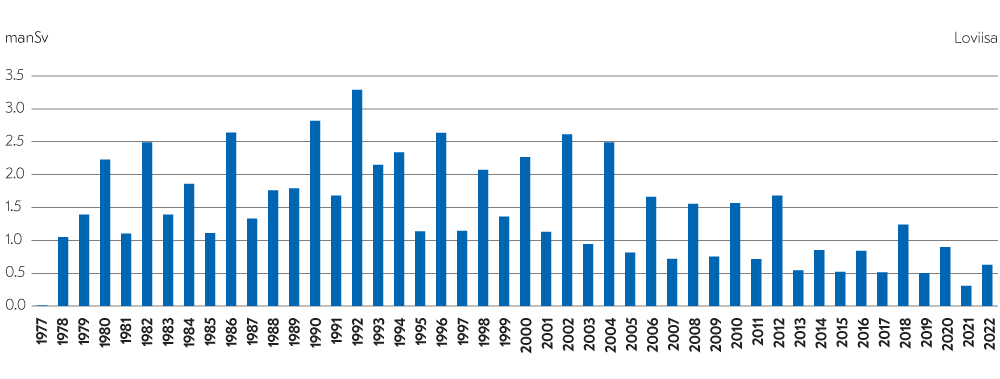
The diagram shows the collective radiation doses of the employees of the Olkiluoto nuclear power plant starting from the start of operation of the power plant. The new Olkiluoto 3 plant unit has not yet had annual maintenance, which is why its share of Olkiluoto's radiation doses was still less than 1% in 2022.
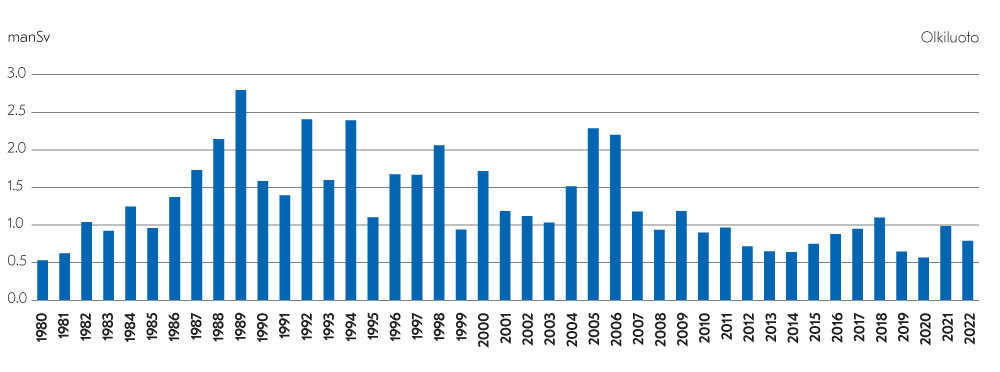
Monitoring of environmental radiation
Environmental studies of Finnish nuclear facilities started already before the facilities were commissioned, and now the surroundings of the facilities are monitored through a comprehensive and diverse range of methods. STUK grants approvals for the facilities’ environmental monitoring programmes and also performs its own independent monitoring.
Every year, approximately 600 samples are collected from the surroundings of the facilities and analyzed. Sample collection locations include, but are not limited to, household water, foodstuffs, air, rainwater, the ground, seawater and the seabed. External background radiation and radioactivity in people living in surrounding areas is also measured regularly. Radiation exposure of the residents near the nuclear power plants is assessed annually based on power plants’ discharge data and environmental samples as well as meteorological measurements.
Discharges from nuclear power plants are effectively absorbed into the massive amounts of air and water around them; that is, into the atmosphere and the sea. For this reason, radioactive substances accumulate in the environment around the power plants in minuscule quantities that can only be detected by highly sensitive measurement methods (see the results of environmental radiation monitoring). The amount of substances discharged from the plant during normal use is so small that it is impossible to measure the radiation dose to which the population is exposed. For this reason, radiation doses are defined through analytical estimation.
Radiation exposure for residents in surrounding areas
Radiation exposure of the residents is assessed annually based on power plants’ discharge data and environmental samples as well as meteorological measurements. In Finland, the Government has set a radiation dose limit of 0.1 millisieverts per year for individual residents in areas surrounding nuclear power plants, when the radiation is caused by normal operation in the plants. This is about one sixtieth of the average radiation dose received by Finns from different sources during the year. In recent years, the radiation dose caused by nuclear power plants in Finland to nearby residents has been less than one percent of the dose constraint.
The models used for assessing the radiation doses of the residents of the vicinity of a nuclear facility cannot fully take into account the individual differences between people and their lifestyles. Therefore, the models define a so-called representative person who represents a population group that gets the highest exposure due to their age and lifestyle. The representative person is an imaginary person living in the vicinity of a nuclear power plant. Her or she eats mainly natural products collected from the surroundings of the power plant, such as berries, mushrooms and fish, drinks milk from a nearby farm and uses local grain and meat products. In addition, he or she spends a lot of time on the sea shores near the nuclear power plant and swims in the sea. The result is very conservative – in practice, it represents the maximum radiation dose that a person could receive while living in the vicinity of a nuclear power plant. In reality, people living near nuclear power plants are exposed to much smaller radiation doses.
If a nuclear power plant discharged so much radioactive substances that it increased the radiation levels in the vicinity, the monitoring networks around the plants would detect the situation immediately. The networks are made up of measuring stations located 1–5 kilometres away, from which information is sent directly to the computers at the plants and can be checked at any time by the Radiation and Nuclear Safety Authority. If the dose rate at a plant increases above the alarm limit of 0.4 microsieverts per hour, the system automatically sends an alert to STUK’s emergency team. In Finland, naturally occurring background radiation varies from 0.05 to 0.30 microsieverts per hour (µSv/h).
Regulatory oversight of nuclear safety in Finland : Annual report 2024 (julkari.fi)
The estimated dose of a person representing the most exposed population group in Olkiluoto and Loviisa during the entire lifetime of the plants. As a result of changes to the plant and its processes, both sites have significantly reduced their emissions, which has also reduced the dose to the most exposed person in their surroundings. Currently, the largest part of the dose is caused by the nuclide carbon-14 in discharges into the atmosphere.
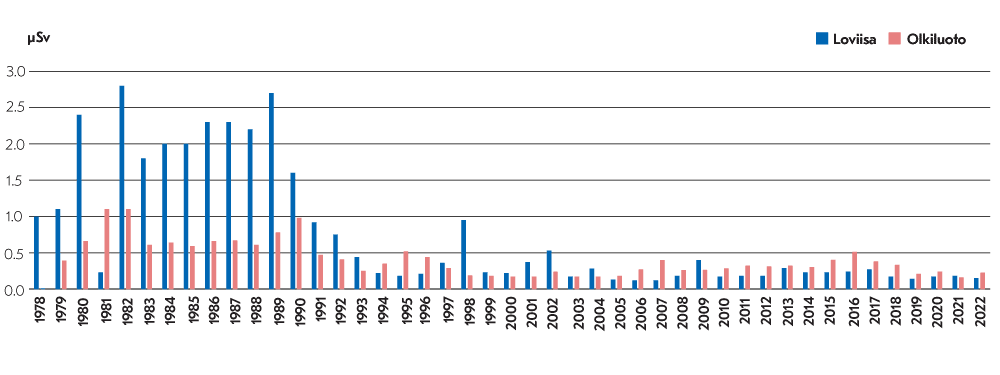
Radiation dose calculated for an individual from the most exposed (critical) group in the environment around the Loviisa nuclear power plant has remained under 1 percent of the 100 μSv limit set in the Nuclear Energy Decree (161/1988). In 2013, 2017 and 2021 the Loviisa plant discharged low-level evaporation waste, as planned, into the sea. For this reason, the doses of the critical group are slightly higher compared to the other years.
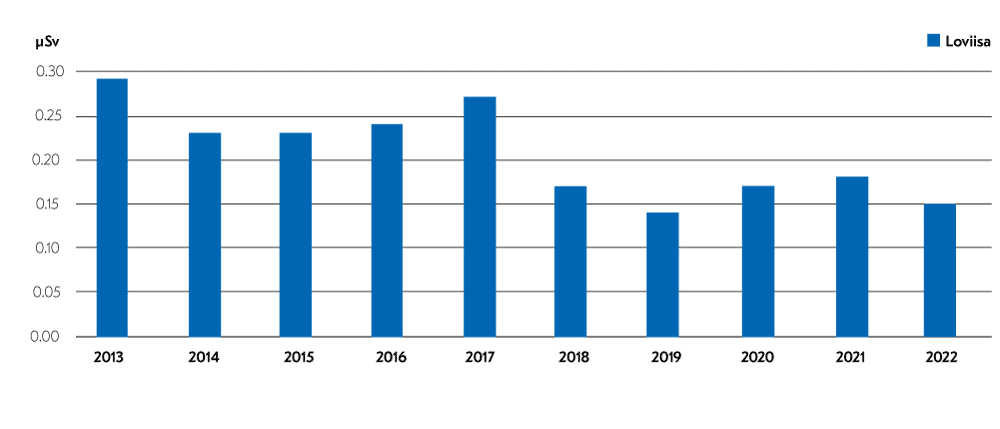
Radiation dose calculated for an individual from the most exposed (critical) group in the environment around the Olkiluoto nuclear power plant. Despite the fuel leakages during the years 2016-2019, the radiation doses from Olkiluoto were still very low, less than 1% of the 100 μSv limit set in the Nuclear Energy Decree (161/1988).
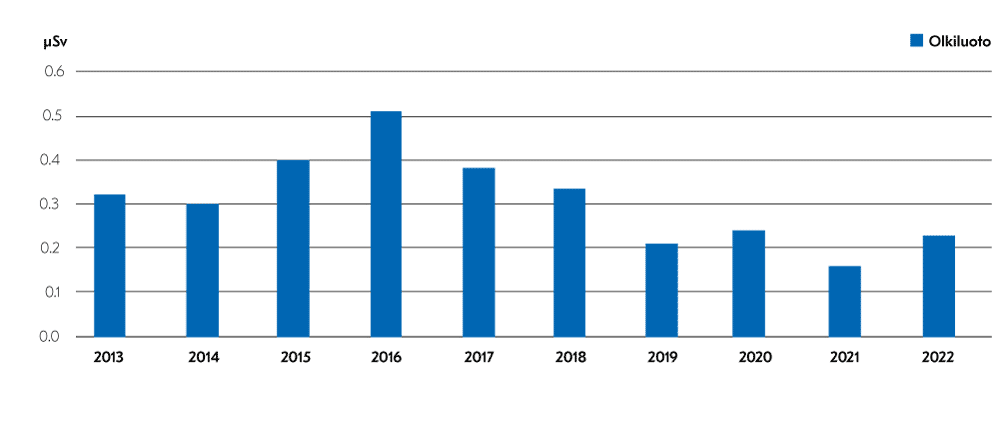
Discharges of radioactive substances
The radioactive substances generated in a nuclear reactor mainly remain trapped in the nuclear fuel. However, a small part of the substances are also in the reactor cooling system and attached cleaning and waste systems. The facility’s water and air discharges are cleaned by filtering and delayed so that their radiation impact on the environment is very small compared to the effect of radioactive substances which occur normally in nature. Discharges are measured carefully and ensured to be clearly below the limits set. The aim is to keep the discharges as low as possible through practical measures.
Gaseous discharges are led to the power plant’s ventilation chimneys and water discharges are led into the sea along with the cooling water. A sample is taken from every batch of liquid discharged from the power plant before it is released into the sea. In addition, the activity of the discharges is measured through continuous radioactivity measurements. Before the discharge of gaseous substances, the radioactive substances in the discharge are measured with continuous radiation meters. Air samples are also continuously collected for more precise discharge analyses. Nuclear power plant companies use precise measurement methods to determine the composition and activity levels of the radioactive substances in the samples.
Nuclear power plant companies report discharge data to STUK on a quarterly basis. The methods of measurement of nuclear power plant discharges have been approved by STUK. STUK regularly inspects the power plants’ discharge systems.
In the analysis of the substances discharged into the atmosphere from nuclear power plants in Finland, an average of ten to twenty different radioactive substances are detected each year. The most common nuclides discharged into the atmosphere were tritium, carbon-14, argon-41, chromium-51, manganese-54, cobalt-58 and -60, silver-110m, antimony-122 and 124, iodine-131 and cesium-137. Other radionuclides detected in the discharges from nuclear power plants in Finland include: iron-59, arsenic-76, bromine-82, different isotopes of krypton (-85m, -87 and -88), niobium-95, tellurium-123m, various isotopes of iodine (-132, -133 and -135), caesium-134 and various isotopes of xenon (-133, -133m, -135, -135m and -138).
The discharge data are used to evaluate the radiation exposure of residents around the nuclear power plant.
Loviisa
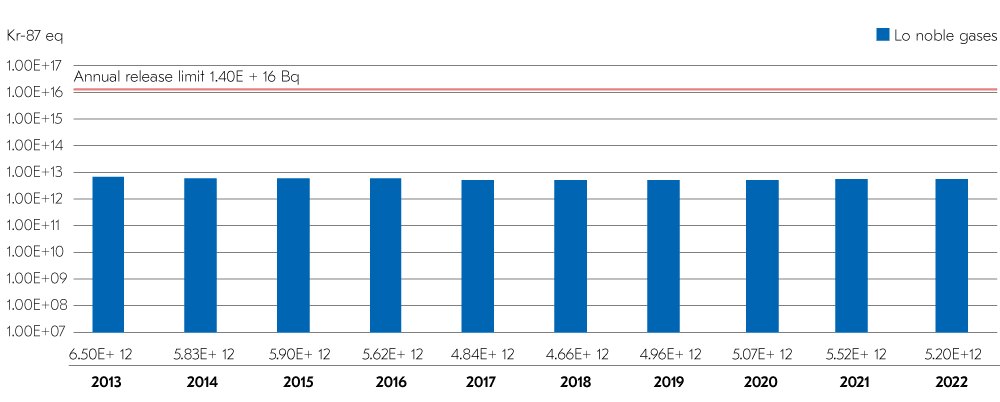
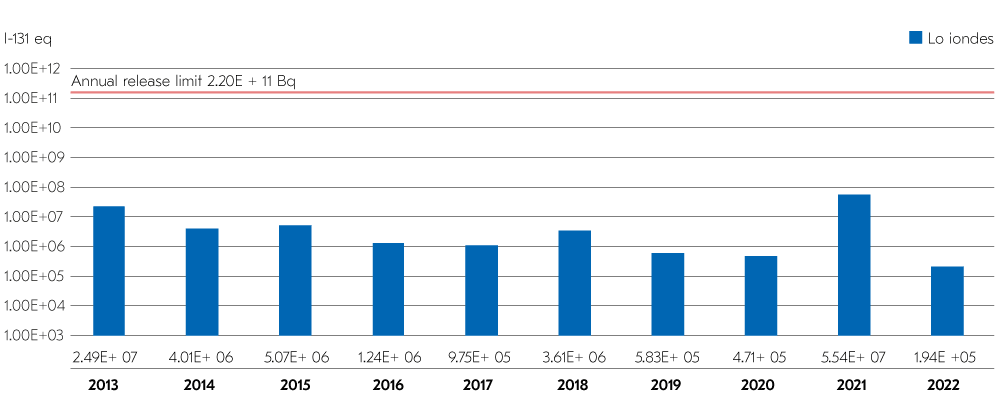
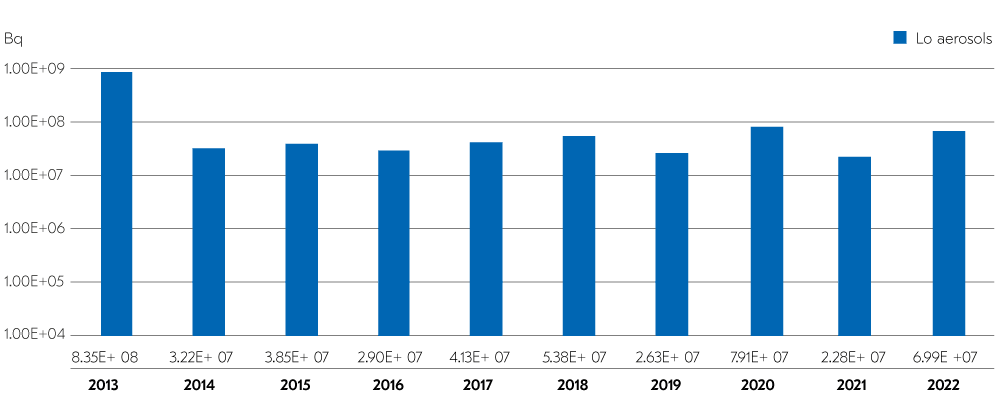
Olkiluoto
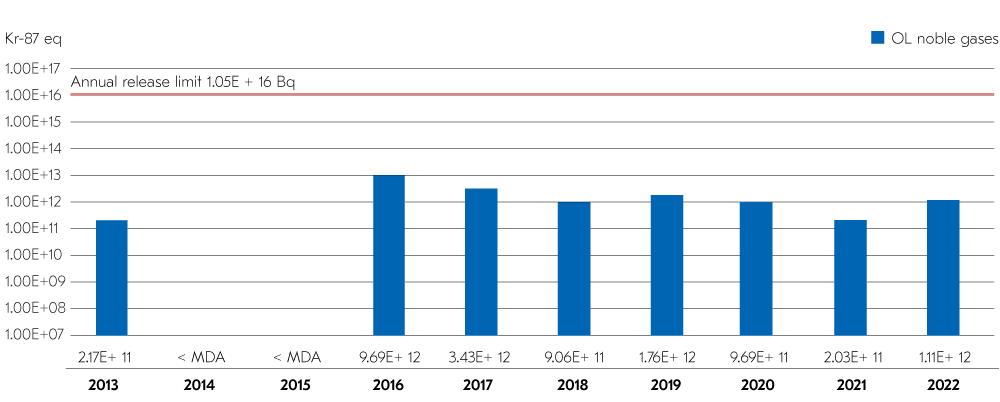
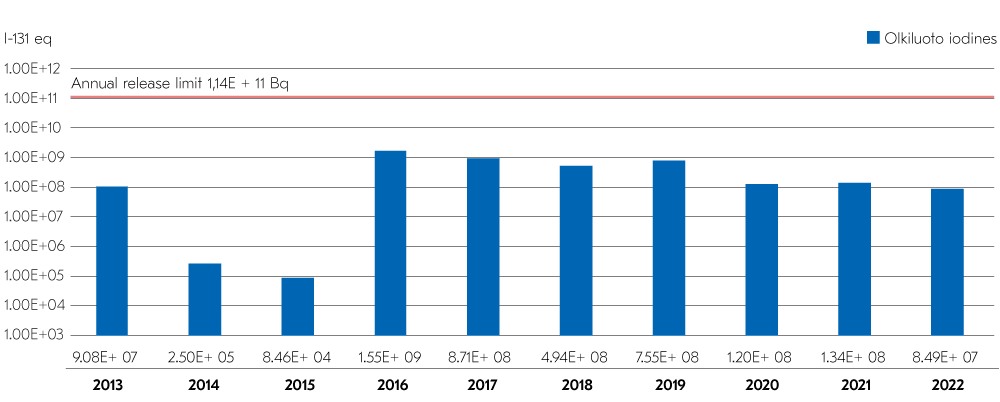
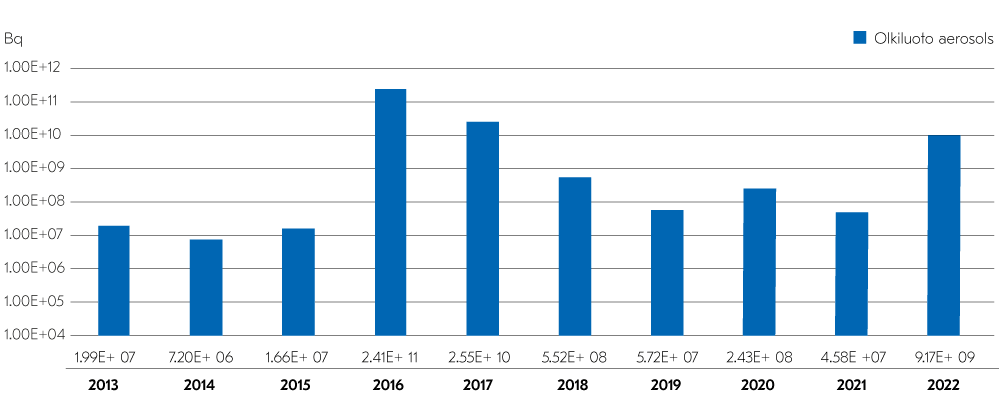
In the analysis of the substances discharged into the sea from nuclear power plants in Finland, an average of ten to twenty different radioactive substances are detected each year. The most common nuclides discharged into the sea were tritium, chromium-51, manganese-54, cobalt-58 and -60, niobium-95, zirconium-95, silver-110m, antimony-122 and -124, iodine-131 and -133 and caesium-134 and -137. The following radionuclides have also been detected in the discharges: sodium-24, potassium-42, iron-59, tin-125 and antimony-125.
The discharge data are used to evaluate the radiation exposure of residents around the nuclear power plant.
